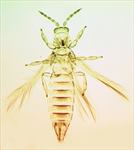
Female
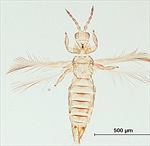
Female

Antenna
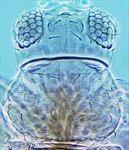
Head & pronotum

Pronotum, mesonotum & metanotum

Tergites V–VIII
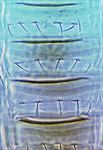
Sternites IV–VII

Male, drepanae on tergite IX

Male, hind femur & tibia

Fore wing
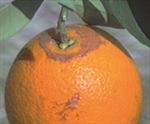
Feeding damage on orange
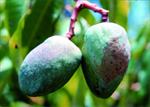
Feeding damage on mango
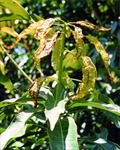
Feeding damage on mango leaf
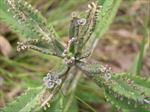
Feeding damage to Mother of Millions
Both sexes fully winged. Body mainly yellow, with dark brown antecostal ridge on tergites and sternites and small brown area medially; antennal segment I white, II–III pale, V–VIII brown; major setae dark; fore wings pale but clavus shaded. Antennae 8-segmented; III & IV each with forked sense cone. Head wider than long; ocellar triangle and postocular region with closely spaced sculpture lines; 3 pairs of ocellar setae present, pair III close together between anterior margins of hind ocelli; two pairs of major postocular setae present. Pronotum with closely spaced sculpture lines; posterior margin with 4 pairs of setae, S2 prominent and about 30 microns long. Metanotal posterior half with irregular longitudinal reticulations; median setae close to anterior margin; no campaniform sensilla. Fore wing first vein with 3 setae on distal half, second vein with 3 widely spaced setae; posteromarginal cilia wavy. Abdominal tergites III – VI median setae small, close together; II–VIII with lateral thirds covered in closely spaced rows of fine microtrichia, these microtrichial fields with three discal setae, posterior margin with fine comb; tergite VIII with comb complete across posterior margin, lateral discal microtrichia extending across middle of tergite; tergite IX with no discal microtrichia. Sternites without discal setae, covered with rows of microtrichia; posterior margins with comb of short microtrichia between marginal setae.
Male smaller than female; tergite IX posterior angles bearing pair of stout curved drepanae extending across tergite X; hind femora with comb-like row of stout setae; sternites without pore plates.
The genus Scirtothrips currently includes 100 listed species from various parts of the world. Bailey (1964) provided keys to 13 from North America, but that work was based on specimens that were not fully cleared, and thus few structural details were available concerning differences between species. The identity and validity of certain of the species from California requires further study based on freshly mounted, fully cleared specimens. Similarly, Johansen & Mojica-Guzman (1999) provided keys to 37 species from Mexico, but Hoddle et al. (2008) recognised five of these as synonyms of S. perseae, and Mound & Hoddle (2016) placed a further 15 as synonyms of S. citri. Hoddle & Mound (2003) provided information on 21 Scirtothrips species from Australia, and Rugman-Jones et al. (2006) produced a molecular key to several pest species in this genus. Relationships between various Scirtothrips species based on molecular data were further considered by Hoddle, Heraty et al. (2008).
Highly polyphagous, and recorded from plants in about 30 different families. Breeding on the young tissues of leaves and fruits. This results in the distortion of young leaves and the surface scarring of citrus fruits, leading to downgrading of a crop.
Described from South Africa, and widespread through eastern Africa to Egypt, also West Africa and Cape Verde Islands; introduced to Queensland, Australia, but not known from California.
THRIPIDAE - THRIPINAE
Scirtothrips aurantii Faure
Scirtothrips aurantii Faure, 1929: 3
Scirtothrips acaciae Moulton, 1930: 200.
Bailey SF (1964) A revision of the genus Scirtothrips Shull (Thysanoptera: Thripidae). Hilgardia 35: 329–362.
Garms BJ, Mound LA & Schellhorn NA. 2013. Polyphagy in the Australian population of South African citrus thrips (Scirtothrips aurantii Faure). Australian Journal of Entomology 52: 282–289.
Johansen RM, Mojica-Guzman A (1999) The genus Scirtothrips Shull, 1909 (Thysanoptera: Thripidae, Sericothripini), in Mexico. Folia Entomologica Mexicana 104: 23–108.
Hoddle MS, Mound LA, Rugman-Jones PF & Stouthamer R (2008) Synonomy of five Scirtothrips species (Thysanoptera: Thripidae) described from Avocados (Persea americana) in Mexico. Florida Entomologist 91: 16–21.
Mound L & Hoddle M (2016) Scirtothrips species (Thysanoptera, Thripidae) described from mango, Mangifera indica, in Mexico. Florida Entomologist 99 (4):759–764.
Rugman Jones PF, Hoddle MS, Mound LA, & Stouthamer R (2006) Molecular identification key for pest species of Scirtothrips (Thysanoptera: Thripidae). Journal of Economic Entomology 99: 1813–1819.